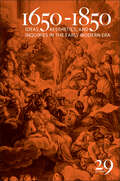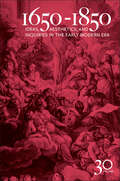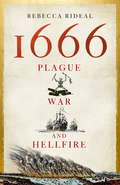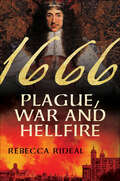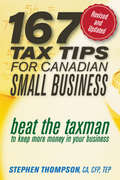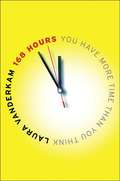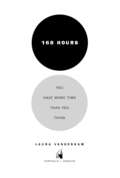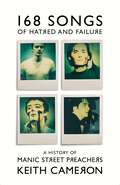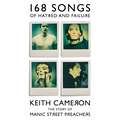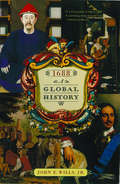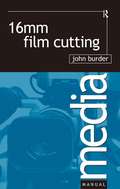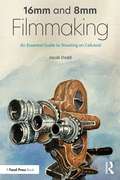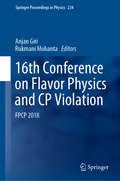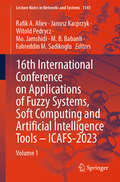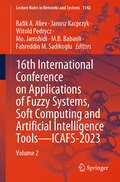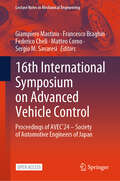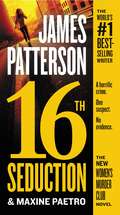- Table View
- List View
1650-1850: Ideas, Aesthetics, and Inquiries in the Early Modern Era (Volume 29) (1650-1850 #29)
by Deborah Kennedy Greg Clingham Paul Tankard Christopher Johnson Susan Spencer Elizabeth Kraft Anthony W. Lee Ileana Baird Christina Ionescu Christopher Trigg Gefen Bar-On Santor John Knapp Paul DeGategno Jeanne M. Britton Angelina Dulong Mona Scheuermann Leigh D. Dillard Catherine J. Theobald Timothy Erwin Laurence Roussillon-Constanty Yanzhang Cui Duane Coltharp Thomas Hothem John C. Traver Courtney A. HoffmanExploratory, investigative, and energetically analytical, 1650–1850 covers the full expanse of long eighteenth-century thought, writing, and art while delivering abundant revelatory detail. Essays on well-known cultural figures combine with studies of emerging topics to unveil a vivid rendering of a dynamic period, simultaneously committed to singular genius and universal improvement. Welcoming research on all nations and language traditions, 1650–1850 invites readers into a truly global Enlightenment. Topics in volume 29 include Samuel Johnson’s notions about the education of women and a refreshing account of Sir Joseph Banks’s globetrotting. A guest-edited, illustration-rich, interdisciplinary special feature explores the cultural implications of water. As always, 1650–1850 culminates in a bevy of full-length book reviews critiquing the latest scholarship on long-established specialties, unusual subjects, and broad reevaluations of the period. ISSN 1065-3112 Published by Bucknell University Press, distributed worldwide by Rutgers University Press.
1650-1850: Ideas, Aesthetics, and Inquiries in the Early Modern Era (Volume 30) (1650-1850)
by Christopher D. Johnson Susan Spencer Lynn Festa Anthony W. Lee Victoria Barnett-Woods Ashley Bender Yvonne Fuentes Melanie Hayes Pamela F. Phillips Michael J. Mulryan Duane Coltharp Courtney A. Hoffman Flavio Gregori Steven Minuk Andie Barrow Ross W. Beales Jr. Stephanie Koscak Corey Risinger Youenhee Kho Donald W. Nichol Christopher VilmarExploratory, investigative, and energetically analytical, 1650–1850 covers the full expanse of long-eighteenth-century thought, writing, and art while delivering abundant revelatory detail. Essays on well-known cultural figures combine with studies of emerging topics to unveil a vivid rendering of a dynamic period, simultaneously committed to singular genius and universal improvement. The contributors to volume 30 join with Enlightenment thinkers in pulling, pushing, and stretching the elastic boundaries of human experience. Essays on comical apocalypticism, the evolution of satire, and the Asian periphery of English literature open a volume that offers two special features on extreme aspects of a modernizing world. The first probes the undiscovered world of last wills and testaments, while the second explores the soaring world of eighteenth-century birds. As always, 1650–1850 culminates in a bevy of book reviews critiquing the latest scholarship on long-established specialties, unusual subjects, and broad reevaluations of the period. Published by Bucknell University Press. Distributed worldwide by Rutgers University Press. ISSN: 1065-3112
1666: Plague, War and Hellfire
by Rebecca Rideal1666 was a watershed year for England. The outbreak of the Great Plague, the eruption of the second Dutch War and the Great Fire of London all struck the country in rapid succession and with devastating repercussions.Shedding light on these dramatic events, historian Rebecca Rideal reveals an unprecedented period of terror and triumph. Based on original archival research and drawing on little-known sources, 1666: Plague, War and Hellfire takes readers on a thrilling journey through a crucial turning point in English history, as seen through the eyes of an extraordinary cast of historical characters. While the central events of this significant year were ones of devastation and defeat, 1666 also offers a glimpse of the incredible scientific and artistic progress being made at that time, from Isaac Newton's discovery of gravity to Robert Hooke's microscopic wonders. It was in this year that John Milton completed Paradise Lost, Frances Stewart posed for the now-iconic image of Britannia, and a young architect named Christopher Wren proposed a plan for a new London - a stone phoenix to rise from the charred ashes of the old city.With flair and style, 1666 shows a city and a country on the cusp of modernity, and a series of events that forever altered the course of history.
1666: Plague, War and Hellfire
by Rebecca Rideal1666 was a watershed year for England. The outbreak of the Great Plague, the eruption of the second Dutch War and the Great Fire of London all struck the country in rapid succession and with devastating repercussions.Shedding light on these dramatic events, historian Rebecca Rideal reveals an unprecedented period of terror and triumph. Based on original archival research and drawing on little-known sources, 1666: Plague, War and Hellfire takes readers on a thrilling journey through a crucial turning point in English history, as seen through the eyes of an extraordinary cast of historical characters. While the central events of this significant year were ones of devastation and defeat, 1666 also offers a glimpse of the incredible scientific and artistic progress being made at that time, from Isaac Newton's discovery of gravity to Robert Hooke's microscopic wonders. It was in this year that John Milton completed Paradise Lost, Frances Stewart posed for the now-iconic image of Britannia, and a young architect named Christopher Wren proposed a plan for a new London - a stone phoenix to rise from the charred ashes of the old city.With flair and style, 1666 shows a city and a country on the cusp of modernity, and a series of events that forever altered the course of history.
1666: Plague, War and Hellfire
by Rebecca Rideal1666 was a watershed year for England. An outbreak of the Great Plague, the eruption of the second Dutch War, and the devastating Great Fire of London all struck the country in rapid succession and with devastating repercussions.Shedding light on these dramatic events and their context, historian Rebecca Rideal reveals an unprecedented period of terror and triumph. Based in original archival research drawing on little-known sources, 1666 opens with the fiery destruction of London before taking readers on a thrilling journey through a crucial turning point in English history as seen through the eyes of an extraordinary cast of historical characters. While the central events of this significant year were ones of devastation and defeat, 1666 also offers a glimpse of the incredible scientific and artistic progress being made at that time, from Isaac Newton’s discovery of gravity to the establishment of The London Gazette. It was in this year that John Milton completed Paradise Lost, Frances Stewart posed for the iconic image of Britannia, and a young architect named Christopher Wren proposed a plan for a new London—a stone phoenix to rise from the charred ashes of the old city.With flair and style, 1666 exposes readers to a city and a country on the cusp of modernity and a series of events that altered the course of history.
167 Tax Tips for Canadian Small Business: Beat the Taxman to Keep More Money in Your Business
by Stephen Thompson"...a book for every Canadian in a small or home-based business who is struggling with complex tax rules and regulations." —Dale Ennis, Canadian MoneySaver "...easy-going style and avoidance of the more mind-numbing details make for a solid primer on the perks and pitfalls of self-employment. The...one-sentence tips in the appendix are probably worth the price of admission alone." —Gordon Powers, The Globe and Mail "...one of the better books I've seen on the market for small-business owners and better yet, it's all Canadian content." —Linda A. Fox, The Toronto Sun As a small-business owner or a home-based entrepreneur, you have lots of questions about taxes, but very few answers. Fortunately for you, 167 Tax Tips for Canadian Small Business contains a wealth of tax planning advice and strategies to help you save on your business tax bill. So whether you want to do it yourself or reduce what you pay your accountant - not to mention the government - this is how you'll keep more money in your pocket, where it belongs. Packed with tax tips that will save you hundreds, or even thousands, of dollars year-round. Written in a question-and-answer format that's easy to understand, practical, and easy to apply. Features 167 "Tax Beaters" - quick-reference tips that highlight key points - plus three bonus tips to help you save even more! Explains how to save taxes in every aspect and at every stage of your business. Features a Year-Round Tax-Planning Calendar. Coverage includes: business start-up, corporate tax planning, GST/HST, deductibility of home and automobile expenses, what to do if you are audited by the Canada Revenue Agency, CPP and QPP deductions for self-employed entrepreneurs, and much more. The ultimate "tax coach" for every Canadian in a small or home-based business, this book will help you to beat the taxman at his own game!
168 Hours: You Have More Time Than You Think
by Laura VanderkamThere are 168 hours in a week, and Vanderkam presents a new approach to getting the most out of them. She draws on her own experience and the stories of other successful people who have fulfilled their goals why allocating their time accordingly.
168 Hours: You Have More Time Than You Think
by Laura VanderkamThere are 168 hours in a week. This book is about where the time really goes, and how we can all use it better. It's an unquestioned truth of modern life: we are starved for time. With the rise of two-income families, extreme jobs, and 24/7 connectivity, life is so frenzied we can barely find time to breathe. We tell ourselves we'd like to read more, get to the gym regularly, try new hobbies, and accomplish all kinds of goals. But then we give up because there just aren't enough hours to do it all. Or else, if we don't make excuses, we make sacrifices. To get ahead at work we spend less time with our spouses. To carve out more family time, we put off getting in shape. To train for a marathon, we cut back on sleep. There has to be a better way-and Laura Vanderkam has found one. After interviewing dozens of successful, happy people, she realized that they allocate their time differently than most of us. Instead of letting the daily grind crowd out the important stuff, they start by making sure there's time for the important stuff. They focus on what they do best and what only they can do. When plans go wrong and they run out of time, only their lesser priorities suffer. It's not always easy, but the payoff is enormous. Vanderkam shows that it really is possible to sleep eight hours a night, exercise five days a week, take piano lessons, and write a novel without giving up quality time for work, family, and other things that really matter. The key is to start with a blank slate and to fill up your 168 hours only with things that deserve your time. Of course, you probably won't read to your children at 2:00 am, or skip a Wednesday morning meeting to go hiking, but you can cut back on how much you watch TV, do laundry, or spend time on other less fulfilling activities. Vanderkam shares creative ways to rearrange your schedule to make room for the things that matter most. 168 Hours is a fun, inspiring, practical guide that will help men and women of any age, lifestyle, or career get the most out of their time and their lives.
168 Songs of Hatred and Failure: A History of Manic Street Preachers
by Keith Cameron'A forensic exploration of their compositions and recordings, and everything that has been poured into them . . . completely definitive' MOJO ★★★★★ The story of Manic Street Preachers is unique in pop. Raging out of the stricken mining communities of south Wales in the late 80s, they were seemingly condemned to mere cult status by a cruel juncture of artistic triumph, commercial failure and personal despair. The story took a further agonising twist when the tragedy of Richey Edwards' 1995 disappearance was followed by a remarkable rebirth, built upon 'A Design For Life' - a hymn to the band's working-class roots - and then the award-winning, multi-million-selling album Everything Must Go, a majestic soundtrack to history and loss. Within five years, Manic Street Preachers were playing to 60,000 at the national stadium of Wales and had their second UK Number 1 single. Subsequent output has confirmed the band as both a wellspring of restless creativity and a barometer of the cultural conversation.Because it was music that saved them, it's through the prism of their music that Keith Cameron tells the definitive history of Manic Street Preachers, drawing on many hours of new interviews to dive deep into 168 songs, from 1988 debut single 'Suicide Alley' to the late day peaks of 2025 album Critical Thinking. Writing with the band's full co-operation, his book charts the dynamic evolution of a universe in which Karl Marx and Kylie Minogue happily co-exist, that accords Rush and The Clash equal favour, and where Morrissey & Marr meet Torvill & Dean via Nietzsche and New Order in a single four-minute pop song - all in the name of what Nicky Wire himself calls 'the fabulous disaster' of Manic Street Preachers.
168 Songs of Hatred and Failure: A History of Manic Street Preachers
by Keith Cameron'A forensic exploration of their compositions and recordings, and everything that has been poured into them . . . completely definitive' MOJO ★★★★★ The story of Manic Street Preachers is unique in pop. Raging out of the stricken mining communities of south Wales in the late 80s, they were seemingly condemned to mere cult status by a cruel juncture of artistic triumph, commercial failure and personal despair. The story took a further agonising twist when the tragedy of Richey Edwards' 1995 disappearance was followed by a remarkable rebirth, built upon 'A Design For Life' - a hymn to the band's working-class roots - and then the award-winning, multi-million-selling album Everything Must Go, a majestic soundtrack to history and loss. Within five years, Manic Street Preachers were playing to 60,000 at the national stadium of Wales and had their second UK Number 1 single. Subsequent output has confirmed the band as both a wellspring of restless creativity and a barometer of the cultural conversation.Because it was music that saved them, it's through the prism of their music that Keith Cameron tells the definitive history of Manic Street Preachers, drawing on many hours of new interviews to dive deep into 168 songs, from 1988 debut single 'Suicide Alley' to the late day peaks of 2025 album Critical Thinking. Writing with the band's full co-operation, his book charts the dynamic evolution of a universe in which Karl Marx and Kylie Minogue happily co-exist, that accords Rush and The Clash equal favour, and where Morrissey & Marr meet Torvill & Dean via Nietzsche and New Order in a single four-minute pop song - all in the name of what Nicky Wire himself calls 'the fabulous disaster' of Manic Street Preachers.
168 Songs of Hatred and Failure: A History of Manic Street Preachers
by Keith Cameron'A forensic exploration of their compositions and recordings, and everything that has been poured into them . . . completely definitive' MOJO ★★★★★ The story of Manic Street Preachers is unique in pop. Raging out of the stricken mining communities of south Wales in the late 80s, they were seemingly condemned to mere cult status by a cruel juncture of artistic triumph, commercial failure and personal despair. The story took a further agonising twist when the tragedy of Richey Edwards' 1995 disappearance was followed by a remarkable rebirth, built upon 'A Design For Life' - a hymn to the band's working-class roots - and then the award-winning, multi-million-selling album Everything Must Go, a majestic soundtrack to history and loss. Within five years, Manic Street Preachers were playing to 60,000 at the national stadium of Wales and had their second UK Number 1 single. Subsequent output has confirmed the band as both a wellspring of restless creativity and a barometer of the cultural conversation.Because it was music that saved them, it's through the prism of their music that Keith Cameron tells the definitive history of Manic Street Preachers, drawing on many hours of new interviews to dive deep into 168 songs, from 1988 debut single 'Suicide Alley' to the late day peaks of 2025 album Critical Thinking. Writing with the band's full co-operation, his book charts the dynamic evolution of a universe in which Karl Marx and Kylie Minogue happily co-exist, that accords Rush and The Clash equal favour, and where Morrissey & Marr meet Torvill & Dean via Nietzsche and New Order in a single four-minute pop song - all in the name of what Nicky Wire himself calls 'the fabulous disaster' of Manic Street Preachers.
1688: A Global History
by John E. Wills Jr.A vivid picture of the world centered around that pivotal year.
1688: A Global History
by John E. Wills Jr."A totally absorbing book...imaginative and erudite, full of startling juxtapositions and flashes of real perception."--Jonathan D. Spence John E. Wills's masterful history ushers us into the worlds of 1688, from the suicidal exaltation of Russian Old Believers to the ravishing voice of the haiku poet Basho. Witness the splendor of the Chinese imperial court as the Kangxi emperor publicly mourns the death of his grandmother and shrewdly consolidates his power. Join the great caravans of Muslims on their annual pilgrimage from Damascus and Cairo to Mecca. Walk the pungent streets of Amsterdam and enter the Rasp House, where vagrants, beggars, and petty criminals labored to produce powdered brazilwood for the dyeworks. Through these stories and many others, Wills paints a detailed picture of how the global connections of power, money, and belief were beginning to lend the world its modern form. "A vivid picture of life in 1688...filled with terrifying violence, frightening diseases...comfortingly familiar human kindnesses...and the intellectual achievements of Leibniz, Locke, and Newton."--Publishers Weekly
1688: The First Modern Revolution
by Steve PincusFor two hundred years historians have viewed England's Glorious Revolution of 1688-1689 as an un-revolutionary revolution--bloodless, consensual, aristocratic, and above all, sensible. In this brilliant new interpretation Steve Pincus refutes this traditional view. By expanding the interpretive lens to include a broader geographical and chronological frame, Pincus demonstrates that England's revolution was a European event, that it took place over a number of years, not months, and that it had repercussions in India, North America, the West Indies, and throughout continental Europe. His rich historical narrative, based on masses of new archival research, traces the transformation of English foreign policy, religious culture, and political economy that, he argues, was the intended consequence of the revolutionaries of 1688-1689. James II developed a modernization program that emphasized centralized control, repression of dissidents, and territorial empire. The revolutionaries, by contrast, took advantage of the new economic possibilities to create a bureaucratic but participatory state. The postrevolutionary English state emphasized its ideological break with the past and envisioned itself as continuing to evolve. All of this, argues Pincus, makes the Glorious Revolution--not the French Revolution--the first truly modern revolution. This wide-ranging book reenvisions the nature of the Glorious Revolution and of revolutions in general, the causes and consequences of commercialization, the nature of liberalism, and ultimately the origins and contours of modernity itself.
16mm Film Cutting (Media Manuals Ser.)
by John BurderThe film editor can make or break a film. What ends up on the cutting room floor, and why? 16mm Film Cutting is a step-by-step guide to film cutting which shows you how to achieve professional results.The practical side of the editor's job is clearly described and illustrated; breaking down rushes and making a simple join, identifying shots, first assembly, avoiding errors, preparing special effects, instructing the labs, compiling sound tracks and all the other stages in producing the final film. 16mm Film Cutting is an indispensable aid to editors and assistants working in all areas of 16mm film production.
16mm and 8mm Filmmaking: An Essential Guide to Shooting on Celluloid
by Jacob DoddThis book is an essential guide to making traditional 16mm and 8mm films, from production to post, using both analog and digital tools. Focusing on low-budget equipment and innovative techniques, this text will provide you with the steps to begin your journey in making lasting work in the legacy medium of great filmmakers from Georges Méliès to Steven Spielberg. The discipline of 16mm or 8mm film can initially seem challenging, but through the chapters in this book, you’ll learn strategies and insight to develop your craft. You’ll discover the right camera for your needs, how to light for film, and the options in planning your digital post-production workflow. The book includes numerous hand-drawn diagrams and illustrations for ease of understanding, as well as recommended films and filmmaking activities to help you build your knowledge of film history, technical and creative skills within each chapter theme.By applying the suggested approaches to production planning, you will see how celluloid filmmaking can be both visually stunning and cost effective. This is an essential book for students and filmmakers who want to produce professional quality 16mm and 8mm films.
16th Chaotic Modeling and Simulation International Conference (Springer Proceedings in Complexity)
by Christos H. Skiadas Yiannis DimotikalisThis proceedings of 16th CHAOS2023 International Conference highlights recent developments in nonlinear, dynamical, and complex systems. The conference was intended to provide an essential forum for Scientists and Engineers to exchange ideas, methods, and techniques in the field of Nonlinear Dynamics, Chaos, Fractals, and their applications in General Science and Engineering Sciences. The principal aim of CHAOS2023 International Conference is to expand the development of the theories of the applied nonlinear field, the methods, empirical data, and computer techniques as well as the best theoretical achievements of chaotic theory. CHAOS2023 Conference provides a forum for bringing together the various groups working in the area of Nonlinear and Dynamical Systems, Chaotic theory, and Application to exchange views and report research findings. Chapter 22 and 23 are available open access under a Creative Commons Attribution 4.0 International License via link.springer.com.
16th Conference on Flavor Physics and CP Violation: FPCP 2018 (Springer Proceedings in Physics #234)
by Anjan Giri Rukmani MohantaPresenting the proceedings of FPCP 2018, this book reviews the status quo of flavor physics and discusses the latest findings in this exciting area. Flavor physics has been instrumental in the formulation and understanding of the standard model, and it is possible that the direction of new physics will be significantly influenced by flavor sector, also known as the intensity frontier, making it possible to indirectly test the existence of new physics up to a very high scale, beyond that of the energy frontier scale accessible at the LHC.The book is intended for academics around the globe involved in particle physics research, professionals associated with the related technologies and those who are interested in learning about the future of physics and its prospects and directions.
16th International Conference on Applications of Fuzzy Systems, Soft Computing and Artificial Intelligence Tools – ICAFS-2023: Volume 1 (Lecture Notes in Networks and Systems #1141)
by Witold Pedrycz Janusz Kacprzyk Rafik A. Aliev Mo. Jamshidi Fahreddin M. Sadikoglu M. B. BabanliThis book covers diverse areas of fuzzy logic, soft computing, and AI approaches such as uncertain computation, decision-making under imperfect information, deep learning, and others. The topics of the papers include theory and application of soft computing, decision theory with imperfect information, neuro-fuzzy technology, intelligent control, machine learning, evolutionary computing, fuzzy logic, and soft computing in engineering, industry, social sciences, business, economics, earth sciences, material sciences, and others. This book presents the proceedings of the 16th International Conference on Applications of Fuzzy Systems, Soft Computing, and Artificial Intelligence Tools, ICAFS-2023, held in Antalya, Turkey, on September 14–15, 2023. This will be a useful guide for academics, practitioners, and graduates in fields of fuzzy systems and soft computing. It would allow for attracting of interest in development and applying of these paradigms in various real fields.
16th International Conference on Applications of Fuzzy Systems, Soft Computing and Artificial Intelligence Tools – ICAFS-2023: Volume 2 (Lecture Notes in Networks and Systems #1142)
by Witold Pedrycz Janusz Kacprzyk Rafik A. Aliev Mo. Jamshidi Fahreddin M. Sadikoglu M. B. BabanliThis book covers diverse areas of fuzzy logic, soft computing, and AI approaches such as uncertain computation, decision-making under imperfect information, deep learning, and others. The topics of the papers include theory and application of soft computing, decision theory with imperfect information, neuro-fuzzy technology, intelligent control, machine learning, evolutionary computing, fuzzy logic, and soft computing in engineering, industry, social sciences, business, economics, earth sciences, material sciences, and others. This book presents the proceedings of the 16th International Conference on Applications of Fuzzy Systems, Soft Computing, and Artificial Intelligence Tools, ICAFS-2023, held in Antalya, Turkey, on September 14–15, 2023. This will be a useful guide for academics, practitioners, and graduates in fields of fuzzy systems and soft computing. It would allow for attracting of interest in development and applying of these paradigms in various real fields.
16th International Conference on Information Technology-New Generations (Advances in Intelligent Systems and Computing #800)
by Shahram LatifiThis 16th International Conference on Information Technology - New Generations (ITNG), continues an annual event focusing on state of the art technologies pertaining to digital information and communications. The applications of advanced information technology to such domains as astronomy, biology, education, geosciences, security and health care are among topics of relevance to ITNG. Visionary ideas, theoretical and experimental results, as well as prototypes, designs, and tools that help the information readily flow to the user are of special interest. Machine Learning, Robotics, High Performance Computing, and Innovative Methods of Computing are examples of related topics. The conference features keynote speakers, the best student award, poster award, service award, a technical open panel, and workshops/exhibits from industry, government and academia.
16th International Conference on Soft Computing Models in Industrial and Environmental Applications (Advances in Intelligent Systems and Computing #1401)
by Héctor Quintián Emilio Corchado Pablo García Bringas Hugo Sanjurjo González Iker Pastor LópezThis book of Advances in Intelligent and Soft Computing contains accepted papers presented at SOCO 2021 conference held in the beautiful and historic city of Bilbao (Spain), in September 2021.Soft computing represents a collection or set of computational techniques in machine learning, computer science, and some engineering disciplines, which investigate, simulate, and analyze very complex issues and phenomena.After a through peer-review process, the 16th SOCO 2021 International Program Committee selected 78 papers which are published in these conference proceedings and represents an acceptance rate of 48%. In this relevant edition, a special emphasis is put on the organization of special sessions. Seven special sessions are organized related to relevant topics as follows: applications of machine learning in computer vision; soft computing applied to autonomous robots and renewable energy systems; optimization, modeling, and control by soft computing techniques (OMCS); challenges and new approaches toward artificial intelligence deployments in real-world scenarios; time series forecasting in industrial and environmental applications (TSF); soft computing methods in manufacturing and management systems and applied machine learning.The selection of papers was extremely rigorous in order to maintain the high quality of the conference, and we would like to thank the members of the program committees for their hard work in the reviewing process. This is a crucial process to the creation of a high standard conference, and the SOCO conference would not exist without their help.
16th International Symposium on Advanced Vehicle Control: Proceedings of AVEC’24 – Society of Automotive Engineers of Japan (Lecture Notes in Mechanical Engineering)
by Matteo Corno Francesco Braghin Federico Cheli Giampiero Mastinu Sergio M. SavaresiThis open access book highlights the latest advances, innovations, and applications in the field of vehicle systems dynamics and control, as presented by leading international researchers at the 16th JSAE International Symposium on Advanced Vehicle Control (AVEC), held at Politecnico di Milano, Milan, Italy, on September 2-6, 2024. It covers a diverse range of topics such as vehicle dynamics theory, steering, brake, tire, suspension, chassis control, powertrain, electrified vehicles, stability enhancement systems, driver-vehicle systems, advanced driver assistance systems and automated driving systems, driving simulator dynamics and control. The contributions, which were selected by means of a rigorous international peer-review process, present a wealth of exciting ideas that will open novel research directions and foster multidisciplinary collaboration among different specialists.
16th Seduction (Women's Murder Club #16)
by James Patterson Maxine Paetro<P>Detective Lindsay Boxer faces a heart-stopping threat in the newest Women's Murder Club thriller. <P>Fifteen months ago, Detective Lindsay Boxer's life was perfect--she had a beautiful child and a doting husband, Joe, who helped her catch a criminal who'd brazenly detonated a bomb in downtown San Francisco, killing twenty-five people. <P>But Joe wasn't everything that Lindsay thought he was, and she's still reeling from his betrayal as a wave of mysterious, and possibly unnatural, heart attacks claims seemingly unrelated victims across San Francisco. <P>As if that weren't enough, the bomber she and Joe captured is about to go on trial, and his defense raises damning questions about Lindsay and Joe's investigation. <P>Not knowing whom to trust, and struggling to accept the truth about the man she thought she knew, Lindsay must connect the dots of a deadly conspiracy before a brilliant criminal puts her on trial. <P><b>A New York Times Bestseller</b>
16th WCEAM Proceedings (Lecture Notes in Mechanical Engineering)
by Adolfo Crespo Márquez Vicente González-Prida Díaz Joe Amadi-Echendu Juan Francisco Gómez FernándezThis book gathers selected peer-reviewed papers from the 16th World Congress on Engineering Asset Management (WCEAM), held in Seville from 5–7 October 2022. This book covers a wide range of topics in Engineering Asset Management, including: Asset management and decision support system Industry 4.0 tools and its impact on asset management Monitoring, diagnostics and prognostics for smart maintenance Asset life cycle management Asset management in the industrial sector Human dimensions and asset management performance Infrastructure Asset management Asset condition, risk, resilience, and vulnerability assessments Asset operations and maintenance strategies Reliability and resilience engineering Applications of international and local guidelines and standards The breadth and depth of this state-of-the-art, comprehensive proceedings make it an excellent resource for asset management practitioners, researchers and academics, as well as undergraduate and postgraduate students.
